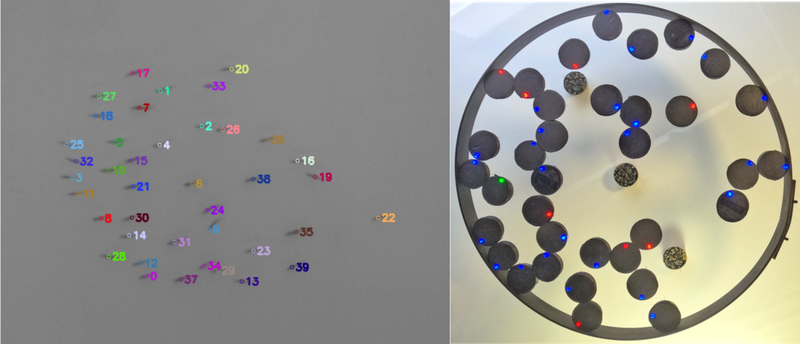Study of the movement and collective behavior of fish, robots and bees
Jun 07, 2023
Julia Múgica Gallart defended her thesis co-directed by Romualdo Pastor-Satorras and M. Carmen Miguel López on June 7, 2023 at the North Campus. Entitled "Collective Motion and Collective Decision-Making in Animal Groups: From Schooling Fish to Swarming Robots" the thesis focuses on empirically and theoretically investigating collective movement in shoals of fish, and collective decision-making in a swarm of robots emulating the selection of a new nesting site for bees.
Collective behavior in animals is ubiquitous in nature. It emerges from the self-organization of interacting individuals within a group. What makes collective behavior so interesting is that the behavior of the group as a whole cannot be predicted from the actions of its individual members alone. In recent decades, there has been a growing interest in understanding how collective behavior emerges from individual interactions. This research has revealed that self-organization in biological systems share common functional properties that can trigger behavioral transitions that endow collectives with adaptive capabilities.
The main objective of this work is to explore the underlying mechanisms from which complex collective behavior can emerge and adapt. We concentrate our analysis in the collective motion of schooling fish and consensus reaching in swarming robots in a model of honeybees nest site selection.
We study the collective motion of black neon tetra (\textit{Hyphessobrycon herbertaxelrodi}) by recording their movements in an experimental tank and using a custom tracking software to extract individual trajectories. Our analysis of the data reveals a strong correlation between swimming speed and collective ordering. We explore this correlation in the Vicsek model, a self-propelled particles model, and discover that the system undergoes a disorder-to-order phase transition with an increase in particles' speed. By modifying the Vicsek model to include periodically oscillating speed, we are able to replicate the black neon tetra's type of locomotion. This suggests that fish can reduce the effect of noise by increasing their speed and favoring alignment forces. Modulating directional synchronization through speed has adaptive benefits, enabling faster and more efficient transfer of information.
We also investigate the presence and characteristics of avalanches in our fish school, which occur when fish abruptly rearrange their direction of motion. We observe that the size and duration of these avalanches follow a scale-free pattern similar to self-organized critical systems. Additionally, certain fish are more likely to initiate avalanches, acting as effective leaders. By incorporating a global leader that periodically changes direction, we replicate in the Vicsek model the intermittent scale-free behavior observed in fish schools. Our findings highlight the importance of individual variability in triggering behavioral cascades
To analyze collective decision-making we study a decentralized model that simulates honeybees' nest site selection process. The model integrates independent site discovery and communication to reach consensus on the best site. We thoroughly characterize the model's parameters in a mean-field approximation and test its feasibility by adding space, locality, and situatedness to the dynamics by using kilobots, small swarming robots capable of exchanging information with neighboring robots. Remarkably, the level of stationary consensu s in our results from kilobots closely matches the consensus stationary values predicted by the mean-field approximation. To explain this result, we examine the connectivity of the kilobots system in our experimental arena, and demonstrate that, from local interactions and mobility, kilobots form a percolating communication network from which they transmit information as efficiently as in the mean-field approximation. The kilobots' movement effectively induces an extension of the interaction radius in respect to the static scenario, which is especially important in the high communication regime. Our results demonstrate that this model can explain honeybees consensus reaching on the best available site by local dynamical interactions.
Our findings inspire further exploration in individuals variability in self-organizing systems, with the aim of developing more comprehensive models and expanding knowledge of the universality of collective behavior.

Share: